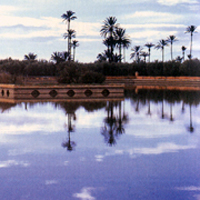
The Marrakesh Agdal (Morocco)
The International Carlo Scarpa Prize for Gardens
XI Annual Award, 2000
The Jury of the International Carlo Scarpa Prize for Gardens has unanimously decided to award the 2000 Prize to the Agdal in Marrakesh, Morocco.
In making the award the Jury wishes to attract attention above all to the distinctive and still visible character of this great rectangular enclosure, 440 hectares laid out as gardens and orchards with square modules interspersing cultivated areas with stands of trees of different species. The overall design originated in Mesopotamia in the VIII century B.C. and spread through Persia to the whole of the Islamic area and well into the Iberian peninsula.
The Agdal itself dates from 1157, when Marrakesh, which had been founded almost a century earlier as the Almoravid capital, became the capital of the empire of the Almohads, the Berber people who were dominant from the Niger to Tunisia and from the Libyan coast to the Tagus.
According to XVI century records the Agdal contained over 66,000 fruit trees, about half of them citrus fruits and the rest various species including pomegranates, plums, grapes, olives, figs, peaches, mulberries, apricots, pears, almonds and jujubes. An inventory made in 1916, at the beginning of the French Protectorate, shows that there were still 51,000 fruit trees, the majority of them olives.
The award is also intended to draw attention to the role of the Agdal in the original and continuing definition of the forma urbis of Marrakesh. The city’s medina, declared as a World Heritage Site by UNESCO, forms an indivisible whole with the Agdal, defended by a stout 10 kilometre-long perimeter wall. But the city and its wonderful garden, the inhabitants and their crops, are able to live together thanks to the systematic channelling of water resources over hundreds of square kilometres of the Haouz Plain, which itself made the settlement geographically and historically possible. From the middle of the XI century the “hidden water” of underground streams flowing down from the Altas Mountains and from rainfall was channelled into over five hundred subterranean conduits called khettara, with an estimated overall length of around 700 kilometres, dug by hand from at least 70,000 well-shafts. For over a century, from the middle of the XI century to the middle of the XII, the system supplied as much as 3,200 litres of water a second and created the indispensable basis for the establishment of the imperial capital. From the middle of the XII century the “hidden water” system was also supported by the “visible water” of a network of open-air canals.
It is this astonishingly large-scale conception, extension and achievement that the Jury wishes to highlight, dedicating the financial contribution to new studies and research and by so doing attract attention and action from the international community.
The Agdal encapsulates all the history and the geography of the Haouz. Inside the enclosure, the rectangular basins of Dar al-Hanâ and al-Ghrsiyya, like the basin of the Ménara, reflect the white outline of the mountains and the unruly spray of the palm-tree tops. Here too the science, technical skill and culture of the age-old Islamic civilization that created them still show their capacity to transform the severity of the climate and the hostility of nature into flourishing and productive beauty. The image of this raised stretch of water that summons the sky and draws it down towards earth in fact conveys a dual meaning. On the one hand utility, because it is the raw material that makes it possible to irrigate or flood the parts of the gardens as the rules and rhythms of time require it; on the other, pleasure, because the flat, horizontal surface of the water and the reflection of the sky induce a profound sense of peace, serenity and contemplation.
Text taken from the 2000 Carlo Scarpa Prize Statement, edited by the Jury.
